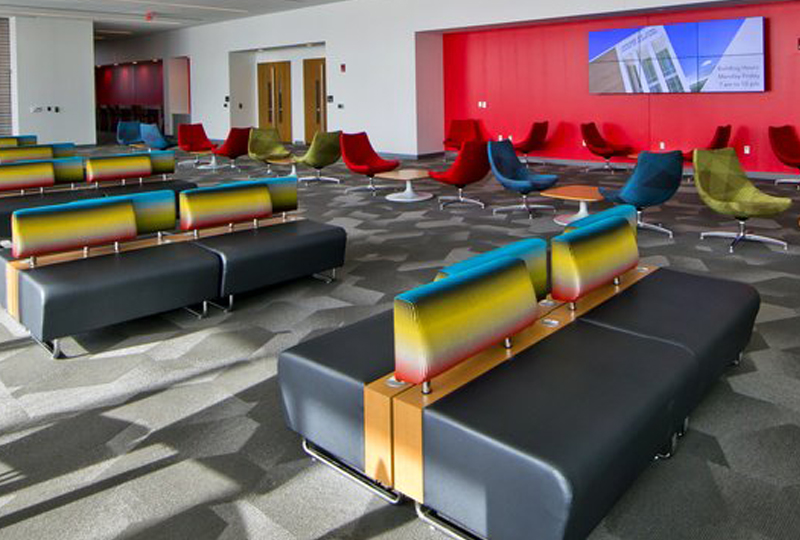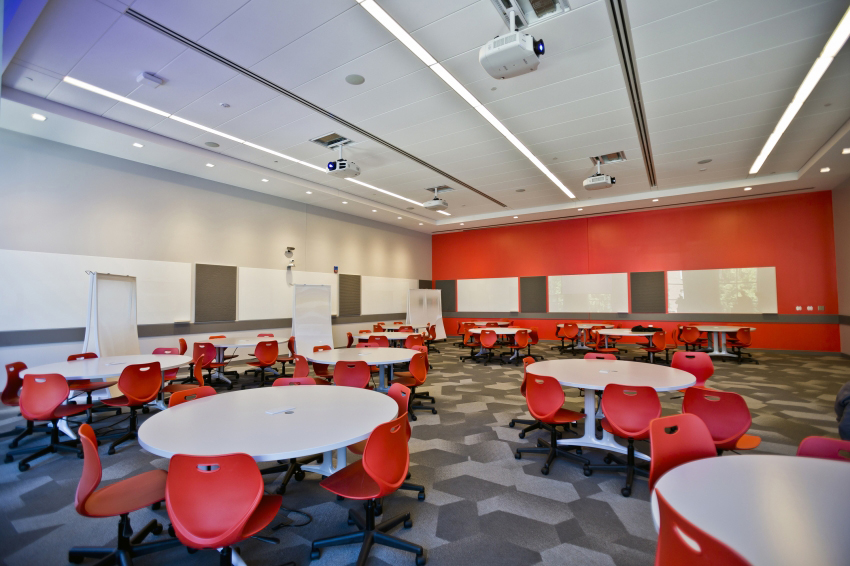Education Dive | Autumn A Arnett
Dive Brief:
The University of Maryland is one of a number of institutions across the country that is re-designing its physical spaces to better achieve the teaching and learning outcomes the university has identified as optimal, as it looks to move away from the traditional professor-at-the-front lecture style.
The new Edward St. John building on the College Park main campus features classroom layouts including six-round pod-style classrooms, comprised of a number of tables that each sit six students, and media classrooms, which feature oblong tables against the wall, each centered around a large screen for working collaboratively and sharing media. Even traditional lecture halls are designed with seats that swivel to promote more interaction between students.
Students strongly prefer these new spaces because of the higher levels of engagement with peers, said Scott Roberts, director of instructional excellence and innovation in the Teaching & Learning Transformation Center. Roberts said the rooms’ set-ups have a psychological effect, changing the way students see each other as part of a group. “When we transform the classroom, we transform their experience more broadly” and promote a greater sense of support and belonging for students, he said during a recent tour of the new facilities.
Dive Insight:
Education Dive named re-thinking physical spaces as one of our trends to watch for 2018, but like any other change on campus, re-thinking the campus space does not come without challenges. For starters, Roberts said faculty members “conceptually buy into” the “shift from lecturing to student engagement,” but the application is sometimes difficult. And the physical set-up forces faculty members to think more intentionally about how they’re spending class time and pushes them more towards blended learning models, rather than reading a chapter or a pre-written lecture aloud.
For one thing, time is always a concern — you can’t cover nearly as much material in a class block that is set up to be highly interactive and collaborative as you could in a lecture-style course. “It takes longer, so you have to cover less and master more,” Roberts said. This means students must be more accountable for their own learning — highly collaborative models only work if students come to class prepared, having done all of the reading in advance. But, said Roberts, “when you put students in social situations where they’re going to have to talk about this stuff, there’s added social pressure” to make sure they’re prepared ahead of time, he said.
Adding pre-class quizzes and other early assessments can help the professor identify which areas to hone in on for additional instruction. And some instructors create student expert groups that are then responsible for teaching material to peers, holding students accountable for not only their own learning, but each others’. The model works if you make it clear to students on the front-end what you need from them to get out of the material; faculty members will have to be disciplined about starting with the learning outcomes and thinking through how they want students to be different at the end of the class, then design the class time with those things in mind, Roberts said.
“They’ve got to believe it’s not busy work; you’ve got to articulate the value” of what students are being asked to do, he said, adding, “There are a lot of demands on their time, and they have to make choices” about what work to do and what can be put off until later. Often, the highest value material gets the most time.
Roberts is quick to clarify that there aren’t rooms that promote active learning and rooms that don’t, suggesting that faculty members can think more intentionally about the way they’re leading their classes regardless in traditional classrooms too, even if they’re physically moving desks into clusters to promote higher levels of interaction.
But this space is specifically intended to achieve those goals, he said, and it serves as a good springboard to get faculty members thinking differently. “This building is a value statement about what the campus cares about,” he added. Specifically, that the university would create a space that is “dedicated to the future of education.”


